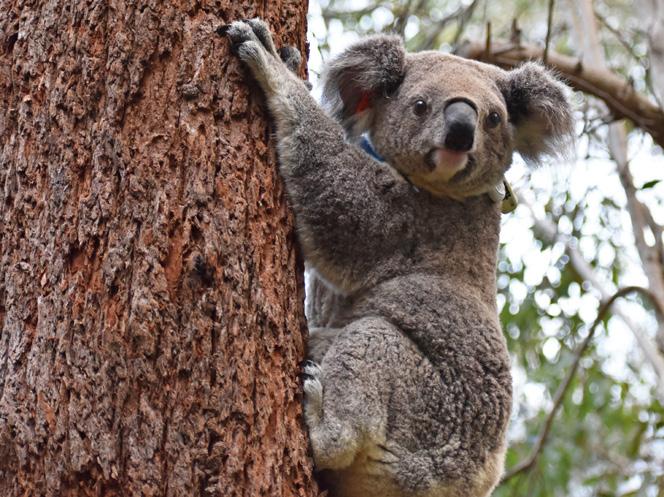
5 minute read
Rainbow leads to a golden opportunity to help local koalas
Redland City Council has partnered with Queensland Rail, Griffith University and University of the Sunshine Coast to help protect koalas living near rail corridors.
It follows GPS tracking of a Redlands Coast ambassador koala which showed its home ranges crossed rail tracks.
A Council koala conservation team spokesperson said the team had been working closely with its research partners to look at local koala movements and explore ways to keep koalas safe from vehicle strikes, including trains.
“GPS tracking data from Rainbow, one of our ambassador koalas in the Ormiston Koala Safe Neighbourhood, showed that her home range crosses the local rail line but we didn’t know exactly where or how she was crossing,” the spokesperson said.
“So, in partnership with Queensland Rail, Griffith University and University of the Sunshine Coast, we set up some cameras along the rail corridor, including the pedestrian underpass near Crossley Drive Park and Kerridge Court.
“Surprisingly, we spotted another young koala using the underpass but nothing from Rainbow yet. Her current joey, Newton, is likely getting too big to carry long distances.
“This information led to Queensland Rail requesting data on koalas living on or near rail lines so they could see where other koalas may be in danger. We sent them koala watch data showing a concentration of recent koala sightings near Wellington Point train station, as well as other smaller points along the line.”
The spokesperson said the program had been assisted by the more than 200 people who had now joined Redlands Coast Koala Watch who, together, lodged more than 600 sightings.
“We have some very active Redlands Coast Koala Watch members in the area, so we were able to show exactly where koalas have been spotted recently. There were quite a few sightings along Saw Mill Drive, Frederick Street and Bilbury Street,” the spokesperson said.
“The data we are collecting from Redlands Coast Koala Watch provides valuable insights for all our koala conservation programs, not just the rail line project. Members are also helping to combat disease and reduce koala deaths by giving each koala they spot a quick visual health check, looking for any common signs of illness or injury and reporting any concerns to the Redlands 24-hour Wildlife Rescue Service.
“Almost 95 percent of the koala sightings submitted to Redlands Coast Koala Watch so far identified the koala as healthy looking and we’d like to thank our koala watchers for being so vigilant with their health checks.
“A few of the koalas sighted as unwell were taken to hospital by our amazing volunteers, where they are getting expert help. Finding these ill koalas quickly greatly improves their chances of making it back home happy and healthy.”
If you’d like to find out how to tell if a koala is ill or injured, check out “how you can help koalas” on Council's website. You can also find out more about Redlands Coast Koala Watch and how to join, as well as follow the adventures and see photographs of each of Redlands Coast’s ambassador koalas via Council’s online koala ambassador map.
The map, which tracks their most recent locations in the four Koala Safe Neighbourhoods in Ormiston (Nandeebie/ Indillie), Thornlands (Nandeebie/Indillie), Birkdale (Cullen Cullen) and Mount Cotton (Jungalpin/Tungipin) has already had more than 4000 views since it was launched in early 2021.
You can find it on the Koala Safe Neighbourhood page on our web site. Go to redland.qld.gov.au/koala and click on the “I want to locate an ambassador koala” link.

Rainbow's joey in her pouch
Photo: University of the Sunshine Coast

Rainbow's joey in her pouch
Photo: University of the Sunshine Coast
Residents to the rescue
Caring residents have stepped in to help some of Redlands Coast's ambassador koalas recently, potentially saving their lives.
Residents who saw Benson walking strangely along a Cleveland (Nandeebie/ Indillie) footpath in late December, called Redlands 24hr Wildlife Rescue Service and he was quickly rescued. In pain and unable to climb to safety due to injured legs, it’s unlikely he would have survived without help. He’s now well on the way to recovery and will be released soon.
Redlands Coast Koala Watch members Celia and Alan Moxon have been helping the University of Sunshine Coast (USC) research team monitor Bark through a Bluetooth tracking app trial. Bark was previously an ambassador koala which had dropped his collar but still had an ear tag. Celia and Alan noticed Bark had a stained, wet bottom and called the wildlife service. He was rescued and treated for cystitis, with early intervention the key to Bark’s survival. He has since rejoined the ambassador program and become the first ambassador koala to be vaccinated through the USC's innovative chlamydia vaccination trial. Miles was also rescued recently after a health check discovered he had peritonitis. He has been regaining weight and will be back on his home range soon.
The research team regularly checks Redlands Coast's ambassador koalas but rely on locals to also keep an eye on them.
If you spot a koala, take a picture and log your sighting with Redlands Coast Koala Watch. Join at redland.qld.gov.au/ koalawatch










